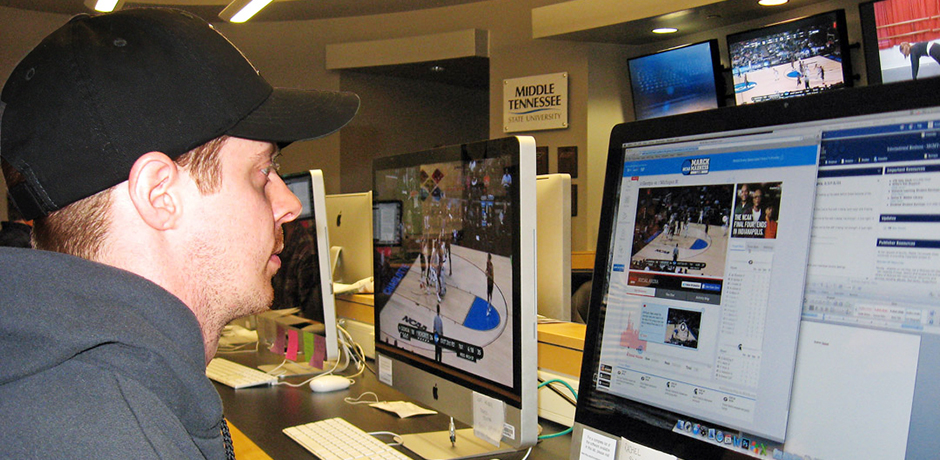As the nation’s top college teams vie for basketball immortality, a dozen MTSU students are clamoring for attention in cyberspace by commenting on all the action.

MTSU student Jake Hapner, a senior from Wabash, Indiana, checks out the Georgia-Michigan State game online March 20 in the Sports and New Media class. (Photos by MTSU News and Media Relations)
Students in Carla Swank’s class on Sports and New Media are tracking and talking about the NCAA Men’s Basketball Tournament on a blog at www.dormroomhoops.com, on Facebook at DormRoomHoops and on Twitter @DormRoomHoops and #drhoops.
The biggest challenge, they say, isn’t keeping up with the shots and the fouls. It’s making sure that every game in the field of 68 is covered, said Swank, a lecturer in the Department of Electronic Media Communication.
“At the beginning of the class, we divided up into beats based on conferences, and they maintained those beats all the way through up until the tournament,” Swank said. “Now it’s more about juggling schedules.”
That means students are working nights and weekends, working around their other classes and their jobs, to complete this classwork. For Twitter, that also means restricting their comments to 140 characters per message.
“There have definitely been times when I wanted to say more than I could,” said Kyle Blevens, a freshman electronic media communication major from Murfreesboro, “but I think you can get it down to where you can have some good information in the amount of characters you have in the tweet.”
“[The readers] don’t want to read a lot,” added Jake Hapner, a senior marketing major from Wabash, Indiana. “They just want a quick update.”
So far, multitasking online does not seem to be an issue. It’s more about finding the right alchemy of circumstances and text that attract the most eyeballs and clicks.
“You can’t force something to go viral,” Swank said. “It doesn’t work that way. So it’s a little bit of luck and a little bit of planning and making sure you’re just constantly producing really good content.”

MTSU’s Carla Swank, a lecturer in the Department of Electronic Media Communication, uses a laptop to find out which of her students’ stories are being read online in her Sports and New Media class. The students are blogging, tweeting and using Facebook to report on the NCAA Men’s Basketball Tournament.
That content must include a short summary, an impact player, a turning point in the game and a quirky anecdote about something out of the ordinary.
Since the class has its own Vine account, the students can capture six-second snippets of looped video from the networks broadcasting the games and embed them into their texts without risking copyright infringement.
That enables the students to illustrate their texts with a super shot, a controversial play or a buzzer-beating winner.
Other art, such as still photos, comes from Getty Images, which will allow embeds free of charge.
The attraction is reportage, analysis and commentary written by college students about their peers, Swank said.
Athlon, a Nashville-based sports media company, picked up one of the students’ Vines, she said, adding that it makes the students feel great when the professionals notice what they’re doing.
Although Hapner hails from Indiana, a state where basketball is almost a religion, he rooted for Michigan State to defeat Georgia March 20 in the second round of the East Regional in Charlotte, North Carolina. In this type of journalism, however, strict objectivity is not necessarily the goal.
“I tend to … tweet for the team that I’m going for, but you just try and get stuff out there that a lot of people will be interested in so you can get more views and retweets,” Hapner said.
— Gina K. Logue (gina.logue@mtsu.edu)


COMMENTS ARE OFF THIS POST